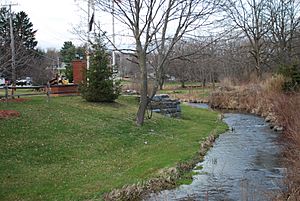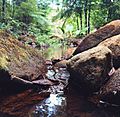Stream facts for kids
A stream is a natural flow of water that moves across the land between its banks. It's usually smaller than a river. Think of it as a moving path of water, always flowing in one direction.

A stream is a body of water that stays within its bed and banks. It always has a noticeable current, meaning the water is moving. You might hear streams called by other names like creek, brook, or run. Sometimes, large streams that boats can travel on are called waterways.
Contents
What Kinds of Streams Are There?
Streams can be different depending on how much water they carry and when they flow.
Streams That Flow All Year or Only Sometimes
In the United States, some streams only flow for part of the year. These are called intermittent streams. On maps, they are shown with a line of blue dashes and dots. In dry areas, like the Southwestern United States, these can be "washes" that only fill up after big thunderstorms or heavy rains.
A blue-line stream flows for most or all of the year. You'll see these marked on maps with a solid blue line. In Australia, what they call a "creek" is often an intermittent stream, but it's still shown with a solid blue line on their maps.
Streams that only appear during and right after it rains are called ephemeral streams. They don't last long!
How We Order Streams
Scientists have a way to classify streams by their "order."
- A first-order stream is a blue-line stream that doesn't have any other blue-line streams flowing into it. It's like the very beginning of a stream system.
- A second-order stream forms when two or more first-order streams join together.
- A third-order stream is created when two or more second-order streams meet. This pattern continues, so a fourth-order stream forms from two or more third-order streams, and so on.
How Streams Change Over Time
Streams change their shape and how they flow as they travel from their source to their end.
Young, Mature, and Old Streams
When a stream first starts, it's often called a "young" stream. These streams usually have:
- Steep slopes (gradients).
- No flat areas next to them (no floodplain).
- Channels that don't move around much.
As a stream gets older, it becomes a "mature" or "old" stream. These streams tend to have:
- Gentler slopes.
- Wide floodplains, which are flat areas next to the stream that can flood.
- Many curves and bends called meanders.
Sometimes, a stream might have curves even when it's still in a "young" stage, but generally, the older a stream gets, the more it meanders.
The Slope of a Stream
The gradient of a stream is how steep its slope is. This is super important because it affects how fast the water flows and how much it can erode the land. The gradient is controlled by something called the base level of erosion.
The base level of erosion is the lowest point a stream can erode down to. This might be where the stream flows into an ocean, a lake, or a pond. It could also be a section where the stream's slope suddenly becomes much flatter.
If the base level is very low, the stream will cut quickly and deeply through the ground, making a steep slope. If the base level is high, the stream will flow more slowly, creating a wider floodplain and more meanders.
Waterfalls and Nickpoints
Sometimes, a stream flows over a very hard rock layer, or its base level suddenly drops (maybe because of a crack in the Earth called a fault). When this happens, the stream's elevation changes suddenly, creating a waterfall or a cascade (a series of small waterfalls). This sudden drop is called a nickpoint. The stream uses a lot of its energy trying to wear down this nickpoint.
How Streams Curve and Form Lakes
Streams rarely flow in a perfectly straight line. They often make big loops and curves.
Meanders and Oxbow Lakes
The looping changes in a stream's direction are called meanders. These curves often look like S-shapes or waves. Over time, these meanders usually move slowly downstream.
However, if something strong (like a tough rock) stops a meander from moving, the stream might cut through the narrow piece of land between two parts of the loop. When this happens, the stream becomes straighter, and the old loop is left behind as a crescent-shaped body of water. This is called an oxbow lake or bayou. A big flood can also cause a meander to be cut off in this way.
Where Streams Begin and End
Every stream has a starting point and an ending point.
Headwaters and Watersheds
The place where a stream begins is called its headwaters or source. This is often in mountains or hills.
The entire area of land that drains water into a stream is called its watershed (also known as a drainage basin). Imagine all the rain that falls on a certain area; it all eventually flows into that stream.
Every watershed is part of a bigger watershed, and it also contains smaller watersheds within it. For example, the Continental Divide in North America separates the land that drains into the Atlantic Ocean from the land that drains into the Pacific Ocean. The Atlantic Ocean watershed itself can be divided into smaller parts, like the Gulf of Mexico drainage.
The Mississippi River watershed is a huge example. It includes the Ohio River watershed, which then includes the Kentucky River watershed, and so on. It's like a giant set of Russian nesting dolls, but with water!
The Mouth of a Stream
The point where a stream empties into a larger body of water, like an ocean, a lake, or another river, is called its mouth. At the mouth, you might find an estuary (where fresh and saltwater mix) or a delta (a fan-shaped landform made of sediment the stream carried).
Underground Streams
Some streams flow underground! They might travel through loose dirt and rocks or through caves. A stream can even flow above ground for a while, then go underground, and then pop back out again. When an underground stream comes out into the open, it's called a spring.
Studying Streams
The study of streams and other waterways is called surface hydrology. It's an important part of understanding our environmental geography and environmental geology.
Other Uses for "Stream"
The word "stream" can also mean other things:
- When you watch videos or listen to music online, that's called streaming media.
- Fast-moving currents of air high up in the atmosphere are called jet streams.
- Large ocean currents, like the Gulf Stream, are sometimes called streams.
Other Pages
Images for kids
-
A rocky creek in Spearfish Canyon, South Dakota, US
-
Creek in Heathcote National Park, Australia
-
Wyming Brook in Sheffield, UK
-
Brook near the Bay of Fundy, Canada
-
A low level stream in Macon County, Illinois, US
-
A small stream in Lake Parramatta, Sydney.
-
Small tributary stream, Diamond Ridge, Alaska, US
-
Creek in Perisher Ski Resort, Australia












